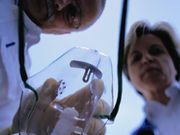No link for fistula formation with penile, caudal block in children undergoing primary hypospadias repair
TUESDAY, Oct. 20, 2015 (HealthDay News) — Caudal regional anesthesia seems not to be associated with urethrocutaneous fistula formation in pediatric patients undergoing primary hypospadias repair, according to a study published in the November issue of Pediatric Anesthesia.
Raza H. Zaidi, M.D., from the University of Michigan in Ann Arbor, and colleagues examined the possible correlation between caudal anesthesia and the risk of fistula formation. Data were included for children who underwent primary hypospadias repair between Jan.1, 1994, and March 31, 2013.
The researchers found that there was no correlation for fistula occurrence with caudal or penile block, severity of postoperative pain, or surgeon experience. Among patients who developed fistula, a more proximal location of the urethral meatus, longer operating time, and use of subcutaneous epinephrine were significantly more common. Compared with closer distance or higher income, distance of more than 100 miles and median household income in the bottom 25th percentile of the study population were not associated with fistula.
“Our findings call into question the routine use of epinephrine in hypospadias repair,” the authors write.
Copyright © 2015 HealthDay. All rights reserved.








